Accepted Scientific Name: Ferocactus cylindraceus var. tortulispinus (H.E.Gates) Bravo
Cact. Suc. Mex. 25: 65. 1980
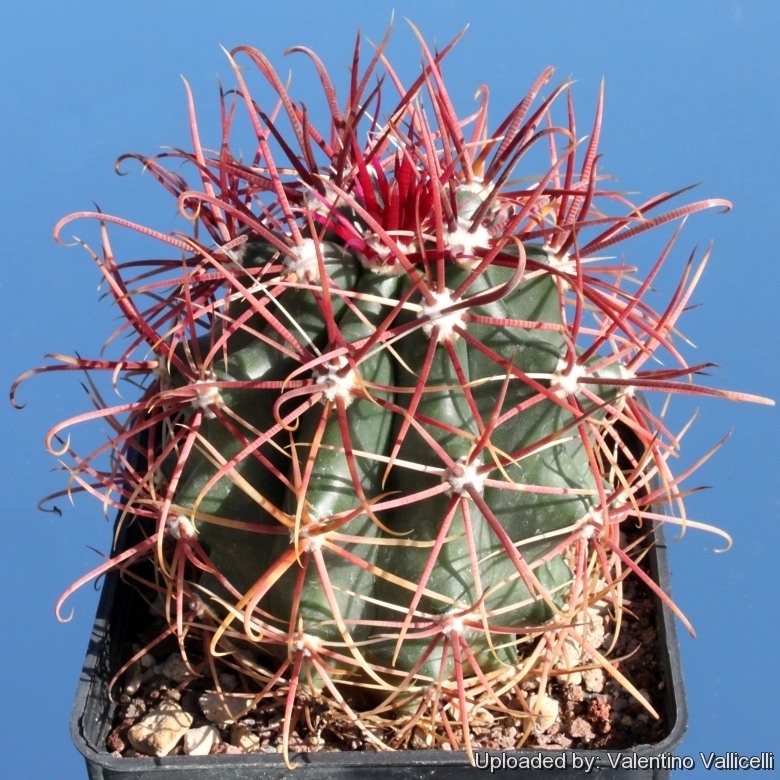
Ferocactus cylindraceus subs. tortulispinus (Ferocactus cylindraceus var. tortulispinus) Photo by: Valentino Vallicelli
Origin and Habitat: Viscaino desert on rocky sites between El Crucero and Cerro Juan to the Laguna Seca Chapala and east to Las Arrastras and Calamajue Misión de Arriola.
Habitat: Grows on volcanic blocks, weathered granite and greenish slate.
Synonyms:
See all synonyms of Ferocactus cylindraceus
Description: Ferocactus cylindraceus var. tortulispinus along with Ferocactus lecontei, and Ferocactus rostiiSN|13971]]SN|10106]] is one of the old controversial geographical forms of the variable Ferocactus cylindraceusSN|10113]]SN|10102]] = (Ferocactus acanthodesSN|10102]]SN|10113]]). It differs from the very similar Ferocactus leconteiSN|10106]]SN|13971]] for the thicker and shorter body (not over 60 cm tall) and for the long dull gray to reddish spines, with the lower central spine that is often twisted and distorted. These features are not always constant and it is probably only a form of the extremely variable Ferocactus cylindraceous. In a single population of Ferocactus cylindraceous, you can find all forms of plants with different number, shape and length of spines. It can happen that two individuals of two different populations can look very similar and also, two plants of the same population can look very different.
Flowers: The stamens are reddish brown (not yellow)
Blooming season: April-May.
Subspecies, varieties, forms and cultivars of plants belonging to the Ferocactus cylindraceus group
 Ferocactus acanthodes (Lem.) Britton & Rose: Plants with a central spine 7-15 cm in length, they usually inhabits the 50-700 m elevational range. (Rejected name same as Feroctus cylindraceus)
Ferocactus acanthodes (Lem.) Britton & Rose: Plants with a central spine 7-15 cm in length, they usually inhabits the 50-700 m elevational range. (Rejected name same as Feroctus cylindraceus) Ferocactus acanthodes f. albispinus hort.: White spined type. Selected cultivated form.
Ferocactus acanthodes f. albispinus hort.: White spined type. Selected cultivated form. Ferocactus acanthodes var. rostii (Britton & Rose) W.T.Marshall: has columnar stems up to 3 m high and 30 cm in diameter. It is similar to F. acanthodes, but the stem is thinner and the spines are more curved and blanch to golden in maturity. Distribution: Texas and California.
Ferocactus acanthodes var. rostii (Britton & Rose) W.T.Marshall: has columnar stems up to 3 m high and 30 cm in diameter. It is similar to F. acanthodes, but the stem is thinner and the spines are more curved and blanch to golden in maturity. Distribution: Texas and California. Ferocactus acanthodes f. variegatus hort.: varigated form.
Ferocactus acanthodes f. variegatus hort.: varigated form.  Ferocactus cylindraceus (Engelm.) Orcutt: Colourfull barrel cactus forming in age a mound of thorns and then a narrow column up to 2m tall, with attractive curved spines that partly obscure the green stem. The spine colour is red but also yellow or pale grey. Distribution: southern California, southwestern Arizona, northern Baja California, and northwestern Sonora.
Ferocactus cylindraceus (Engelm.) Orcutt: Colourfull barrel cactus forming in age a mound of thorns and then a narrow column up to 2m tall, with attractive curved spines that partly obscure the green stem. The spine colour is red but also yellow or pale grey. Distribution: southern California, southwestern Arizona, northern Baja California, and northwestern Sonora. Ferocactus cylindraceus subs. eastwoodiae (L.D.Benson) N.P.Taylor: Plants solitary, short to tall cylindrical up to 3 m high and 30 cmin diameter. Spines dense, partly obscuring the stems, yellowish to straw colored. Distribution: restricted to central Arizona and the Grand Canyon.
Ferocactus cylindraceus subs. eastwoodiae (L.D.Benson) N.P.Taylor: Plants solitary, short to tall cylindrical up to 3 m high and 30 cmin diameter. Spines dense, partly obscuring the stems, yellowish to straw colored. Distribution: restricted to central Arizona and the Grand Canyon. Ferocactus cylindraceus var. hertrichii (Weinberg) hort.: Usually unbranched forming a single column up to 2 m tall and 30cm in diameter. It has a large central spine and three auxiliary centrals form a crucifix shape.
Ferocactus cylindraceus var. hertrichii (Weinberg) hort.: Usually unbranched forming a single column up to 2 m tall and 30cm in diameter. It has a large central spine and three auxiliary centrals form a crucifix shape. Ferocactus cylindraceus subs. lecontei (Engelm.) N.P.Taylor: Plant with untwisted non-hooked central spines 5-7 cm in length often closely pressed to the stem; Distribution: southern Nevada, southwestern Utah, southern California, and much of Arizona. Grows at 700-1500 m in elevation.
Ferocactus cylindraceus subs. lecontei (Engelm.) N.P.Taylor: Plant with untwisted non-hooked central spines 5-7 cm in length often closely pressed to the stem; Distribution: southern Nevada, southwestern Utah, southern California, and much of Arizona. Grows at 700-1500 m in elevation. Ferocactus cylindraceus var. tortulispinus (H.E.Gates) Bravo: It has much shorter stems, often with flattened tips. the spines are very twisted gray. Distribution: northern Baja California.
Ferocactus cylindraceus var. tortulispinus (H.E.Gates) Bravo: It has much shorter stems, often with flattened tips. the spines are very twisted gray. Distribution: northern Baja California.
Bibliography: Major references and further lectures
1) James Cullen, Sabina G. Knees, H. Suzanne Cubey “The European Garden Flora Flowering Plants: A Manual for the Identification of Plants Cultivated in Europe, Both Out-of-Doors and Under Glass” Cambridge University Press, 11/Aug./2011
2) David Hunt, Nigel Taylor “The New Cactus Lexicon” DH Books, 2006 ISBN 0953813444, 9780953813445.
3) Edward F. Anderson “The Cactus Family” Timber Press, 2001
4) Nathaniel Lord Britton, Joseph Nelson Rose “Cactaceae: Descriptions and Illustrations of Plants of the Cactus Family” Courier Dover Publications, 1963
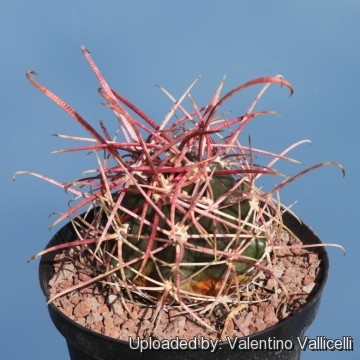 Ferocactus cylindraceus subs. tortulispinus (Ferocactus cylindraceus var. tortulispinus) Photo by: Valentino Vallicelli
Ferocactus cylindraceus subs. tortulispinus (Ferocactus cylindraceus var. tortulispinus) Photo by: Valentino Vallicelli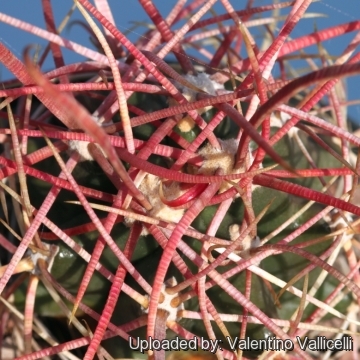 Ferocactus cylindraceus subs. tortulispinus (Ferocactus cylindraceus var. tortulispinus) Photo by: Valentino Vallicelli
Ferocactus cylindraceus subs. tortulispinus (Ferocactus cylindraceus var. tortulispinus) Photo by: Valentino Vallicelli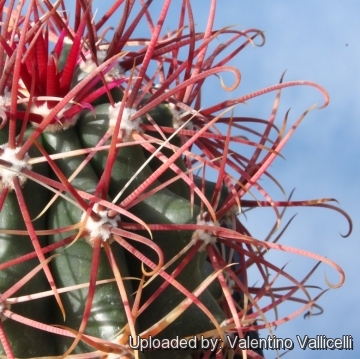 Ferocactus cylindraceus subs. tortulispinus (Ferocactus cylindraceus var. tortulispinus) Photo by: Valentino Vallicelli
Ferocactus cylindraceus subs. tortulispinus (Ferocactus cylindraceus var. tortulispinus) Photo by: Valentino Vallicelli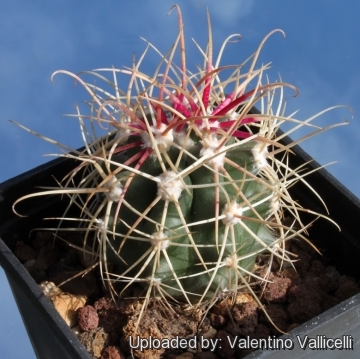 Ferocactus cylindraceus subs. tortulispinus (Ferocactus cylindraceus var. tortulispinus) Photo by: Valentino Vallicelli
Ferocactus cylindraceus subs. tortulispinus (Ferocactus cylindraceus var. tortulispinus) Photo by: Valentino VallicelliCultivation and Propagation: It is a summer-growing and pretty easy plant thought slow to start. It makes great potted specimens, and is a great cactus for beginning collectors.
Growth rate: It is a slow growing species. Plant in good conditions will start to bloom when reach the diameter of only 15-18 cm.
Soil: It grows well in a rich, well drained soil such us clay, pumice, lava grit, and only a little peat or leaf-mould, but it isn't picky about soil.
Repotting: If potted, repot them preferably in the spring, if their roots become cramped. Generally, they should be repotted every other year in order to provide fresh soil. However, this doesn't necessarily mean they'll need larger containers. Fill about a quarter of the pot with broken crocks, gravel, etc. to promote good drainage. After repotting, do not water for a week or more. Use pot with good drainage. Eventually, as the plant becomes mature grow it slowly, and adopt a new repotting period, using intervals of every 2 - 3 years. Additionally grow it under drier conditions or with stronger sunlight.
Watering: Water regularly during the summer so long as the plant pot is allowed to drain and not sit in a tray of water (It rots easily, especially if over wet), and also needs to be avoided wetting the body of this plant while it is in sunlight. A wet cactus in the sun light can cause sun burning which can lead to scars or even fungal infections and death.. Let dry between watering. During hot weather you may need to water the plants more frequently so long as the plant is actively growing. From late September watering should be reduced to force the plant to go in to a state of semi dormancy, by October you should be back in to the winter watering regime. If the soil is allowed to be dry for too long root loss could follow but equally the same result would occur if the plants are both wet and cold. From March onward the plant will begin to grow and watering should be increased gradually until late May when the plant should be in full growth
Fertilization: Feed with a high potassium fertilizer in summer. Feeding may not be necessary at all if the compost is fresh then, feed in summer only if the plant hasn't been repotted recently. Do not feed the plants from September onward as this can cause lush growth which can be fatal during the darker cold months.
Hardiness: When dormant, the plant is very cold tolerant (down to nearly -5° C or less), but when left out it is more sensitive to frost. During the summer it is best to keep the plants outside where the temperature can rise to over 30 C with no harm to the plant. This plants need a period of cool rest in winter to produce flowers abundantly.
Exposure: They do need a lot of light to develop their typical spination, but different clones vary in their tolerance of full sunshine. However some protection in light shade is recommended during the hottest hours in summer. It can tolerate moderate shade, and a plant that has been growing in shade should be slowly hardened off before placing it in full sun as the plant will be severely scorched if moved too suddenly from shade into sun. If kept too dark they may become overly lush and greener and could be prone to rotting due to over watering.
Uses: It is an excellent plant for container growing. It always looks good and stays small. It looks fine in a cold greenhouse and frame.
Diseases and pests: Watch for infestations of mealybugs, scale insects and spider mite. Rot is only a minor problem with cacti if the plants are watered and “aired” correctly. If they are not, fungicides won't help all that much.
Propagation: Seeds are the only way of reproducing, remembering that seedlings dislike strong light and dry conditions and need to be repotted frequently. Seed Collecting: Permit fruit to ripen. Fruit must be significantly overripe before harvesting seed; clean and dry seeds.















